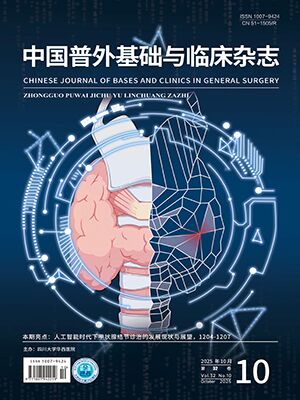| 1. |
Huang J, Sun W, Wang Z, et al. FTO suppresses glycolysis and growth of papillary thyroid cancer via decreasing stability of APOE mRNA in an N6-methyladenosine-dependent manner. J Exp Clin Cancer Res, 2022, 41(1): 42. doi: 10.1186/s13046-022-02254-z.
|
| 2. |
殷德涛, 赵乾. 全球及中国甲状腺癌的发病特征及趋势. 中国普外基础与临床杂志, 2025, 32(6): 687-693.
|
| 3. |
Zhou M, Hua W, Sun Y. Cell migration inducing hyaluronidase 1 promotes growth and metastasis of papillary thyroid carcinoma. Bioengineered, 2022, 13(5): 11822-11831.
|
| 4. |
孙玉霄, 刘维豪, 张逸菲, 等. 青少年甲状腺乳头状癌的临床病理特征及预后分析. 中国普外基础与临床杂志, 2024, 31(11): 1330-1335.
|
| 5. |
Chen P, Cai X, Mu G, et al. Supramolecular nanofibers co-loaded with dabrafenib and doxorubicin for targeted and synergistic therapy of differentiated thyroid carcinoma. Theranostics, 2023, 13(7): 2140-2153.
|
| 6. |
Merlo LM, Pepper JW, Reid BJ, et al. Cancer as an evolutionary and ecological process. Nat Rev Cancer, 2006, 6(12): 924-935.
|
| 7. |
Xiao Y, Yu D. Tumor microenvironment as a therapeutic target in cancer. Pharmacol Ther, 2021, 221: 107753. doi: 10.1016/j.pharmthera.2020.107753.
|
| 8. |
Modi J, Patel A, Terrell R, et al. Papillary thyroid carcinomas from young adults and children contain a mixture of lymphocytes. J Clin Endocrinol Metab, 2003, 88(9): 4418-4425.
|
| 9. |
French JD, Weber ZJ, Fretwell DL, et al. Tumor-associated lymphocytes and increased FoxP3+ regulatory T cell frequency correlate with more aggressive papillary thyroid cancer. J Clin Endocrinol Metab, 2010, 95(5): 2325-2333.
|
| 10. |
Yapa S, Mulla O, Green V, et al. The role of chemokines in thyroid carcinoma. Thyroid, 2017, 27(11): 1347-1359.
|
| 11. |
Ferrari SM, Fallahi P, Galdiero MR, et al. Immune and inflammatory cells in thyroid cancer microenvironment. Int J Mol Sci, 2019, 20(18): 4413. doi: 10.3390/ijms20184413.
|
| 12. |
de Visser KE, Joyce JA. The evolving tumor microenvironment: from cancer initiation to metastatic outgrowth. Cancer Cell, 2023, 41(3): 374-403.
|
| 13. |
Gulubova MV, Ivanova KV. The expression of tumor-associated macrophages and multinucleated giant cells in papillary thyroid carcinoma. Open Access Maced J Med Sci, 2019, 7(23): 3944-3949.
|
| 14. |
Shigeta K, Matsui A, Kikuchi H, et al. Regorafenib combined with PD1 blockade increases CD8 T-cell infiltration by inducing CXCL10 expression in hepatocellular carcinoma. J Immunother Cancer, 2020, 8(2): e001435. doi: 10.1136/jitc-2020-001435.
|
| 15. |
Hu W, Sun R, Chen L, et al. Prognostic significance of resident CD103+CD8+T cells in human colorectal cancer tissues. Acta Histochem, 2019, 121(5): 657-663.
|
| 16. |
Oshi M, Asaoka M, Tokumaru Y, et al. CD8 T cell score as a prognostic biomarker for triple negative breast cancer. Int J Mol Sci, 2020, 21(18): 6968. doi: 10.3390/ijms21186968.
|
| 17. |
Liu J, Lichtenberg T, Hoadley KA, et al. An integrated TCGA pan-cancer clinical data resource to drive high-quality survival outcome analytics. Cell, 2018, 173(2): 400-416.
|
| 18. |
Rosenberg JE, Galsky MD, Powles T, et al. Atezolizumab monotherapy for metastatic urothelial carcinoma: final analysis from the phase Ⅱ IMvigor210 trial. ESMO Open, 2024, 9(12): 103972. doi: 10.1016/j.esmoop.2024.103972.
|
| 19. |
Yang K, Shi Y, Luo M, et al. Identification of a unique tumor cell subset employing myeloid transcriptional circuits to create an immunomodulatory microenvironment in glioblastoma. Oncoimmunology, 2022, 11(1): 2030020. doi: 10.1080/2162402X.2022.2030020.
|
| 20. |
Zhang X, Lan Y, Xu J, et al. CellMarker: a manually curated resource of cell markers in human and mouse. Nucleic Acids Res, 2019, 47(D1): D721-D728. doi: 10.1093/nar/gky900.
|
| 21. |
Ryder M, Ghossein RA, Ricarte-Filho JC, et al. Increased density of tumor-associated macrophages is associated with decreased survival in advanced thyroid cancer. Endocr Relat Cancer, 2008, 15(4): 1069-1074.
|
| 22. |
Geng Y, Shao Y, He W, et al. Prognostic role of tumor-infiltrating lymphocytes in lung cancer: a meta-analysis. Cell Physiol Biochem, 2015, 37(4): 1560-1571.
|
| 23. |
de Kruijf EM, Engels CC, van de Water W, et al. Tumor immune subtypes distinguish tumor subclasses with clinical implications in breast cancer patients. Breast Cancer Res Treat, 2013, 142(2): 355-364.
|
| 24. |
Seo AN, Lee HJ, Kim EJ, et al. Tumour-infiltrating CD8+lymphocytes as an independent predictive factor for pathological complete response to primary systemic therapy in breast cancer. Br J Cancer, 2013, 109(10): 2705-2713.
|
| 25. |
Giraldo NA, Becht E, Pagès F, et al. Orchestration and prognostic significance of immune checkpoints in the microenvironment of primary and metastatic renal cell cancer. Clin Cancer Res, 2015, 21(13): 3031-3040.
|
| 26. |
Giraldo NA, Becht E, Vano Y, et al. Tumor-infiltrating and peripheral blood T-cell immunophenotypes predict early relapse in localized clear cell renal cell carcinoma. Clin Cancer Res, 2017, 23(15): 4416-4428.
|
| 27. |
庞博月, 王晶, 韩颖. CD8+T细胞耗竭发生和特征及其与肿瘤免疫治疗耐药的研究进展. 中国肿瘤临床, 2023, 50(23): 1217-1220.
|
| 28. |
Dolina JS, Van Braeckel-Budimir N, Thomas GD, et al. CD8+T cell exhaustion in cancer. Front Immunol, 2021, 12: 715234. doi: 10.3389/fimmu.2021.715234.
|
| 29. |
Pan B, Wang Z, Yao Y, et al. TGF-β-p-STAT1-LAIR2 axis has a “self-rescue” role for exhausted CD8+T cells in hepatocellular carcinoma. Cell Oncol (Dordr), 2023, 46(6): 1625-1644.
|
| 30. |
Camargo CM, Augusto DG, Petzl-Erler ML. Differential gene expression levels might explain association of LAIR2 polymorphisms with pemphigus. Hum Genet, 2016, 135(2): 233-244.
|
| 31. |
Yang C, Zhang X, Yang X, et al. Function and regulation of RGS family members in solid tumours: a comprehensive review. Cell Commun Signal, 2023, 21(1): 316. doi: 10.1186/s12964-023-01334-7.
|
| 32. |
洪健豪, 张亭, 杨骏, 等. RGS2在泛癌中诊断、预后和免疫浸润的分析. 南昌航空大学学报(自然科学版) , 2023, 37(2): 78-88.
|
| 33. |
Gu X, Gao C, Su X, et al. Targeting BATF2-RGS2 axis reduces T-cell exhaustion and restores anti-tumor immunity. Mol Cancer, 2025, 24(1): 157. doi: 10.1186/s12943-025-02351-5.
|
| 34. |
Valmiki MG, Ramos JW. Death effector domain-containing proteins. Cell Mol Life Sci, 2009, 66(5): 814-830.
|
| 35. |
Alcivar A, Hu S, Tang J, et al. DEDD and DEDD2 associate with caspase-8/10 and signal cell death. Oncogene, 2003, 22(2): 291-297.
|
| 36. |
Song B, Shen S, Fu S, et al. HSPA6 and its role in cancers and other diseases. Mol Biol Rep, 2022, 49(11): 10565-10577.
|
| 37. |
Hu W, Zhao Z, Du J, et al. Interferon signaling and ferroptosis in tumor immunology and therapy. NPJ Precis Oncol, 2024, 8(1): 177. doi: 10.1038/s41698-024-00668-w.
|
| 38. |
Mahmutović S, Beslagić E. Significance of the interferon (IFN) in the therapy. Bosn J Basic Med Sci, 2004, 4(4): 42-44.
|
| 39. |
Parker BS, Rautela J, Hertzog PJ. Antitumour actions of interferons: implications for cancer therapy. Nat Rev Cancer, 2016, 16(3): 131-144.
|
| 40. |
Lazear HM, Nice TJ, Diamond MS. Interferon-λ: immune functions at barrier surfaces and beyond. Immunity, 2015, 43(1): 15-28.
|
| 41. |
Platanias LC. Mechanisms of type-Ⅰ- and type-Ⅱ-interferon-mediated signalling. Nat Rev Immunol, 2005, 5(5): 375-386.
|
| 42. |
Saleiro D, Platanias LC. Interferon signaling in cancer. Non-canonical pathways and control of intracellular immune checkpoints. Semin Immunol, 2019: 101299. doi: 10.1016/j.smim.2019.101299.
|
| 43. |
Siegel JP. Effects of interferon-gamma on the activation of human T lymphocytes. Cell Immunol, 1988, 111(2): 461-472.
|
| 44. |
Ogasawara K, Hida S, Weng Y, et al. Requirement of the IFN-alpha/beta-induced CXCR3 chemokine signalling for CD8+T cell activation. Genes Cells, 2002, 7(3): 309-320.
|
| 45. |
Leone RD, Powell JD. Metabolism of immune cells in cancer. Nat Rev Cancer, 2020, 20(9): 516-531.
|
| 46. |
武多娇, 储以微. 免疫细胞的脂肪酸代谢与肿瘤免疫. 中国肿瘤生物治疗杂志, 2017, 24(10): 1045-1050.
|
| 47. |
Chang CH, Qiu J, O’Sullivan D, et al. Metabolic competition in the tumor microenvironment is a driver of cancer progression. Cell, 2015, 162(6): 1229-1241.
|
| 48. |
Gupta S, Roy A, Dwarakanath BS. Metabolic cooperation and competition in the tumor microenvironment: implications for therapy. Front Oncol, 2017, 7: 68. doi: 10.3389/fonc.2017.00068.eCollection2017.
|
| 49. |
Wang R, Dillon CP, Shi LZ, et al. The transcription factor Myc controls metabolic reprogramming upon T lymphocyte activation. Immunity, 2011, 35(6): 871-882.
|
| 50. |
Patsoukis N, Bardhan K, Chatterjee P, et al. PD-1 alters T-cell metabolic reprogramming by inhibiting glycolysis and promoting lipolysis and fatty acid oxidation. Nat Commun, 2015, 6: 6692. doi: 10.1038/ncomms7692.
|
| 51. |
Lu J, Zhang Y, Sun M, et al. Multi-omics analysis of fatty acid metabolism in thyroid carcinoma. Front Oncol, 2021, 11: 737127. doi: 10.3389/fonc.2021.737127.
|
| 52. |
Liu C, Zhou X, Pan Y, et al. Pyruvate carboxylase promotes thyroid cancer aggressiveness through fatty acid synthesis. BMC Cancer, 2021, 21(1): 722. doi: 10.1186/s12885-021-08499-9.
|
| 53. |
Nava Lauson CB, Tiberti S, Corsetto PA, et al. Linoleic acid potentiates CD8+ T cell metabolic fitness and antitumor immunity. Cell Metab, 2023, 35(4): 633-650.
|
| 54. |
Yang Z, Wei X, Pan Y, et al. A new risk factor indicator for papillary thyroid cancer based on immune infiltration. Cell Death Dis, 2021, 12(1): 51. doi: 10.1038/s41419-020-03294-z.
|
| 55. |
Xu X, Rao G, Gaffud MJ, et al. Clinicopathological significance of major histocompatibility complex class Ⅰ-related chain a and B expression in thyroid cancer. J Clin Endocrinol Metab, 2006, 91(7): 2704-2712.
|
| 56. |
Imai K, Matsuyama S, Miyake S, et al. Natural cytotoxic activity of peripheral-blood lymphocytes and cancer incidence: an 11-year follow-up study of a general population. Lancet, 2000, 356(9244): 1795-1799.
|
| 57. |
López-Soto A, Gonzalez S, Smyth MJ, et al. Control of metastasis by NK cells. Cancer Cell, 2017, 32(2): 135-154.
|
| 58. |
Pinto ML, Rios E, Durães C, et al. The two faces of tumor-associated macrophages and their clinical significance in colorectal cancer. Front Immunol, 2019, 10: 1875. doi: 10.3389/fimmu.2019.01875.
|
| 59. |
van Egmond M, Bakema JE. Neutrophils as effector cells for antibody-based immunotherapy of cancer. Semin Cancer Biol, 2013, 23(3): 190-199.
|
| 60. |
Scapini P, Cassatella MA. Social networking of human neutrophils within the immune system. Blood, 2014, 124(5): 710-719.
|
| 61. |
Tecchio C, Scapini P, Pizzolo G, et al. On the cytokines produced by human neutrophils in tumors. Semin Cancer Biol, 2013, 23(3): 159-170.
|
| 62. |
Varricchi G, Galdiero MR, Loffredo S, et al. Are mast cells MASTers in cancer? Front Immunol, 2017, 8: 424. doi: 10.3389/fimmu.2017.00424.
|
| 63. |
Hölzel M, Landsberg J, Glodde N, et al. A preclinical model of malignant peripheral nerve sheath tumor-like melanoma is characterized by infiltrating mast cells. Cancer Res, 2016, 76(2): 251-263.
|
| 64. |
Luo J, Cheng K, Ji X, et al. Anlotinib enhanced CD8+T cell infiltration via induction of CCL5 improves the efficacy of PD-1/PD-L1 blockade therapy in lung cancer. Cancer Lett, 2024, 591: 216892. doi: 10.1016/j.canlet.2024.216892.
|




